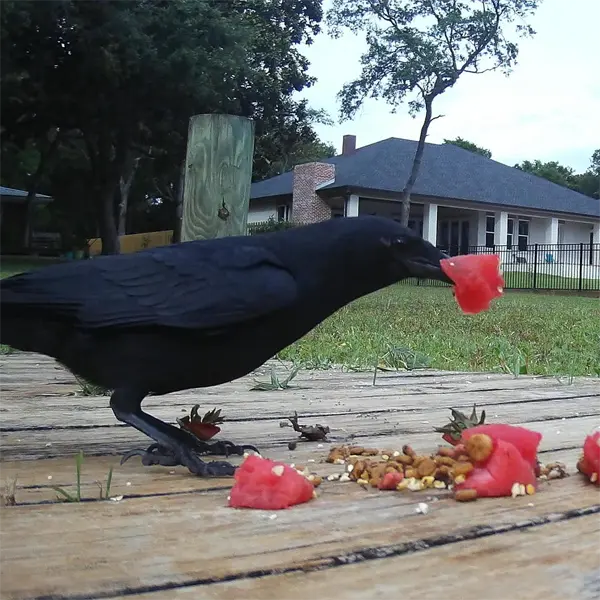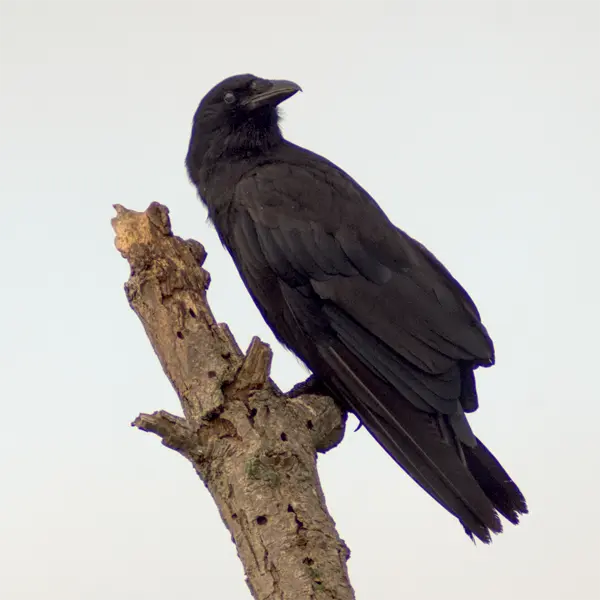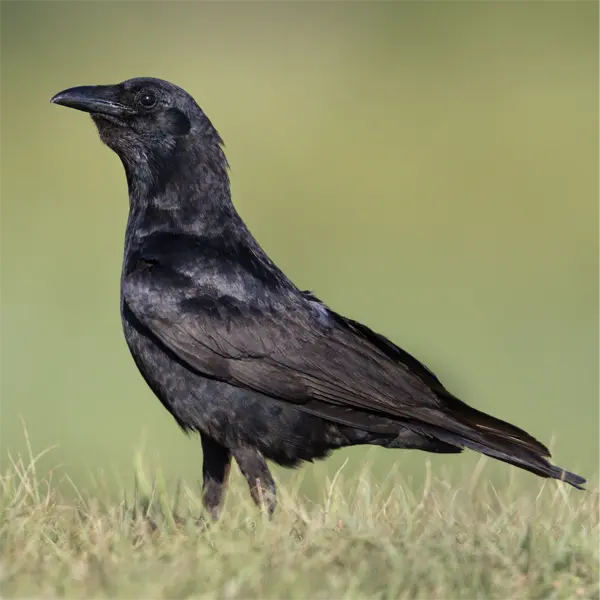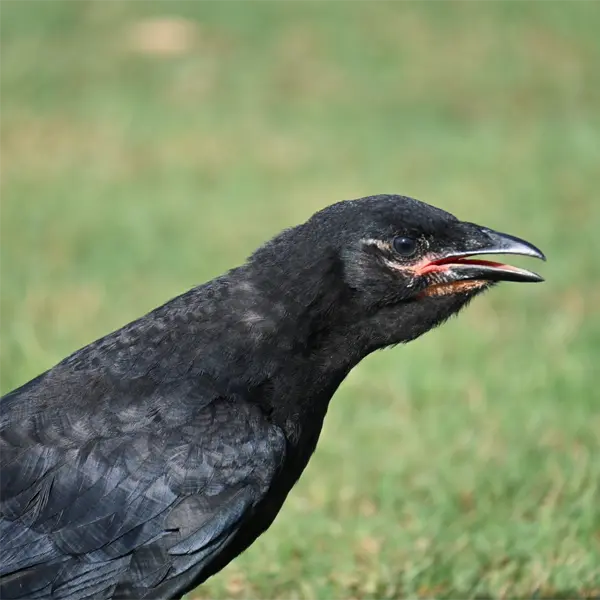Fish Crow
- Scientific Name
- Corvus ossifragus
- Also Known As
- Fish Crow
- Range
- All of Florida Except in the Southwest
- Diet
- Crustaceans, Fish, Eggs, Grains, Fruit
- Life Expectancy
- 7 - 10 Years
Quick Links
The Fish Crow in Central Florida
The fish crow (Corvus ossifragus) is a highly adaptable corvid species found throughout the southeastern United States. As an omnivorous generalist, the fish crow thrives in close proximity to humans across a variety of altered habitats.
This guide provides a comprehensive overview of fish crow biology, behavior, ideal conditions, and management strategies specific to Central Florida.
Appearance and Identification
Fish crows can be distinguished from the near-identical American crow (Corvus brachyrhynchos) based on size, voice, and subtle physical differences
Maturation Rate
Fish crow chicks are altricial at hatching but grow rapidly, attaining flight feathers by 3-4 weeks old. They become independent of parental care around 35-45 days after leaving the nest but remain socially associated. Sexual maturity occurs at 2 years old.
Habits and Behavior
Fish crows are highly social, forming large winter roosts and small family groups during breeding season. They are active throughout the day, often seen strutting on the ground in search of food. Fish crows engage in fascinating cooperative breeding behaviors and raucous communal roosting displays.
Reproduction and Lifespan
Fish crows reach sexual maturity by 2 years old. The breeding season lasts from March to July with peak activity in April and May. They have one brood per year with average clutch sizes around 4-5 eggs. The female incubates the eggs for 16-18 days before they hatch. Both parents feed the young, which fledge around 33 days after hatching.
Fish crows may occasionally engage in cooperative breeding where previous offspring or additional mates help raise chicks at the primary nest. Lifespans in the wild average 7-10 years.
Ideal Habitat and Range
The warm, humid climate of Central Florida provides optimal habitat for fish crow populations. Average temperatures range from the mid 60s°F (18°C) in winter to the low 80s°F (27°C) in summer. Though fish crows inhabit diverse ecosystems nationwide, they thrive in Central Florida’s suburbanized coastal environments:
- Mangrove swamps and salt marshes provide prime nesting sites safe from terrestrial predators.
- Shorelines offer abundant marine invertebrates, fish carcasses, and crustaceans.
- Canals, retention ponds, and flooded fields supply drinking and bathing water.
- Landfills and trash bins provide plentiful anthropogenic food sources.
- Agricultural fields, pastures, and suburban yards provide seeds, fruits, and invertebrates.
As resourceful, flexible foragers, the fish crow continues to expand in Florida amidst wetland destruction and urban sprawl.
Diet and Feeding
Fish crows have diverse omnivorous diets consisting of:
- Insects- beetles, caterpillars, grasshoppers
- Spiders and other arthropods
- Mollusks and crustaceans
- Small fish, eggs, and carrion
- Reptiles – small snakes and lizards
- Amphibians – frogs and salamanders
- Worms and grubs in soil
- Carrion from roadkill and carcasses
- Various seeds and fruits – acorns, berries, citrus
- Grains from agricultural crops
- Human garbage and fast food
Their adaptability allows fish crows to shift from marine to terrestrial foraging as opportunities allow. Fish crows use their curved bill tips to probe and pick food from the ground. Though omnivorous generalists, fish and marine invertebrates comprise over half their diet.

Photo 135270031 © jmcpeak111, CC BY-NC

Common Dangers and Health Risks
While less prone to conflicts as American crows, expanding suburban fish crow populations contribute to nuisance issues in Central Florida:
- Fecal contamination – Fish crow droppings can accumulate on roofs, patio furniture, and pool decks. Feces carry bacteria like E. coli and Salmonella posing health risks if contacted or ingested.
- Noise complaints – Fish crow vocalizations and squabbling are loud and harsh. Dense suburban roosts disturb residents.
- Crop damage – Fish crows damage ripening citrus fruits with their pecking and cause cosmetic defects.
- Structural damage – Nesting materials can clog gutters. Fish crows sometimes peel shingles or rubber membranes while foraging.
- Aircraft strikes – Fish crows foraging near airports are hazardous to aircraft. Their scavenging habits draw them to airfields.
- Predation – Fish crows raid songbird nests to eat eggs and nestlings, reducing avian biodiversity.
While benefits like insect consumption outweigh problems for most, coordinated dispersal, exclusion, or population control may become necessary in some cases.
Preventing American Crow Roosts
Several measures can be taken to deter fish crows from causing nuisances or damage:
- Remove food attractants – Secure trash and eliminate accessible food waste.
- Use deterrents – Shiny tape, predator decoys, and “crow-proof” netting over fruit trees and buildings can dissuade perching and nesting.
- Modify roost sites – Trim trees and reduce dense perching or nesting spots along power lines, light poles, and buildings.
- Population control – Lethal removal or egg oiling techniques may be warranted for specific nuisance flocks.
- Exclusion – Block access to nesting, roosting, and food sites with wire lattice, hardware cloth, or netting.
Prevention is preferable to remediation. Once established, reducing high density suburban fish crow populations becomes challenging and labor-intensive.

Photo 58476393 © aw24680, CC BY-NC
Fish Crows in Central Florida – Conclusion
The adaptable fish crow continues expanding its range across central Florida’s suburbanized coastal environments. Its resourceful foraging provides ecological services like insect control while exploiting human food waste streams. Careful exclusion, moderate population control, and elimination of food attractants can mitigate conflicts with highly dense fish crow groups.
By understanding fish crow biology and behavior patterns, informed management allows us to address problems while supporting populations of this fascinating native corvid species within urban and natural areas. With proactive planning, the benefits of the fish crow can outweigh their costs in Central Florida’s unique interface between the marine and human landscape.







